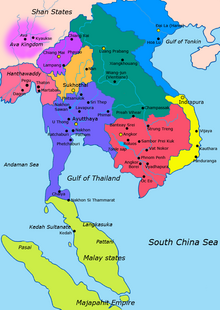Pegu (Empire)
Pegu (after its capital, which is now called Bago ), own name Hongsawatoi ( Pali : Hamsavati , Burmese: Hanthawaddy , Thai Hongsawadi ) was a Mon empire in the south of today's Burma . Hanthawaddy (now a district of the city of Bago) was from 1369 to 1539 the capital of the Mon Kingdom previously known as Ramannadesa ("Land of the Raman").
founding
After the Mongols destroyed the Pagan Empire in 1287 , the Mon regained their independence under Wareru and founded two empires in the south of Burma, first Martaban and then Pegu. In Upper Burma, on the other hand, a Shan- born, but Burmese-speaking dynasty founded the rival empire Ava.
Binnya U, who had been king of Martaban from around 1348, lost control of his old capital around 1363 during a rebellion to the ruler of a neighboring principality and moved with his remaining troops first to Wun and then, after he also acquired this city Rivals lost, according to Pegu, which at the time was little more than a village. The favorable location and good conditions for agriculture probably promoted the rise of Pegus to a regionally important power.
While the terminally ill King Binnya U was still alive, his sister and son-in-law, who presumably had a relationship, took over the actual power. Binnya U's son Rajadhirat (birm .: Razadirat) initially fled, but returned and prevailed against the usurper. He ruled from 1383 to 1421. Rajadhirat was able to win back Wun and in 1388/89 also Martaban. Until 1390 he subjugated the whole sub-company. From 1385 to 1424 Pegu was in the Forty Years War with Ava, the most important rule in Upper Burma. Neither of the two powers could win the war. However, this was a success for Pegu, as Ava had to give up the claim to restore the area of the ancient kingdom of Pagan, which had ruled all of today's Burma until the 13th century.
Heyday
This was followed by the heyday of Pegus. The western kingdom of Arakan temporarily became a vassal of Pegus. Pegu also supported the southern vassals Avas, Prome and Taungu, in rebellions against their supremacy. The Mon Empire was the strongest power in what is now Burma until the 1530s, while Ava's influence declined. Rajadhirats daughter, Queen Baña Thau (real name: Shin Sawbu; 1453–1472), ruled peacefully. She was followed by her son-in-law Dhammazedi (1472-1492), a former Buddhist monk . Under him, Pegu became a center of commerce and Theravada Buddhism .
In the middle of the 16th century, Pegu had developed into a very prosperous state through overseas trade. In Upper Burma, however, the Taungu Kingdom gained supremacy and became a serious rival. The conflict between the Mon-ruled Pegu and the ethnic Burmese-led Taungu centered on the control of resources and revenues from maritime trade, not on ethnic differences. There were ethnic Burmese who fought for Pegu and Mon who were loyal to their Burmese rulers.
The End
In 1539 the area came back under Burmese control when King Tabinshweti of Taungu added it to his empire, reuniting the areas of the former Pagan Empire (and today's Burma). When the Europeans came to Southeast Asia, Burma became an important trading center , so the Taungu dynasty moved the capital of their empire to strategically located Pegu in 1539. In 1599 it was partially destroyed by the Arakanese and their Portuguese and Burmese allies during an intra- Burmese war. In 1635 the capital was moved back to Ava.
In 1740, when the power of the Taungu dynasty waned, the Mon rebelled and briefly became independent again (as the re-established Hongsawatoi Empire ). In 1752 they were able to take Ava and kidnap and later execute the last Taungu king. In 1757 the leader of the emerging Upper Burmese Konbaung dynasty U Aung Zeya (later King Alaungpaya ) conquered the empire, killed his last king and destroyed the city of Pegu. The following year there was another uprising, which he put down. Since then the Mon have not been able to regain their independence. In 1852, the sub-company, i.e. the territory of the former Pegu Empire, was annexed by the British Empire.
literature
- Michael A. Aung-Thwin: The Mists of Rāmañña. The Legend That Was Lower Burma. University of Hawai'i Press, Honolulu 2005.
Individual evidence
- ↑ Jon remote Quest: Rajadhirat's Mask of Command. Military Leadership in Burma (c. 1348-1421). (PDF; 1.2 MB) In: SOAS Bulletin of Burma Research , Volume 4, No. 1, Spring 2006, pp. 4–5.
- ↑ Long Distance Quest: Rajadhirat's Mask of Command. 2006, pp. 5-6.
- ↑ Long Distance Quest: Rajadhirat's Mask of Command. 2006, pp. 7-9.
- ↑ a b Helen James: Pegu. In: Southeast Asia. A Historical Encyclopedia, from Angkor Wat to Timor. ABC-CLIO, 2004, pp. 1044-1045.

